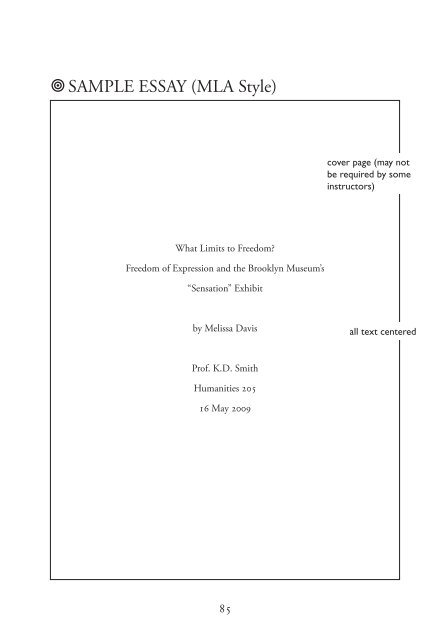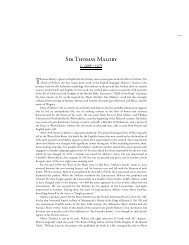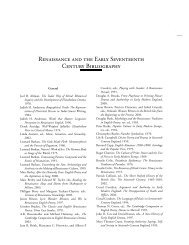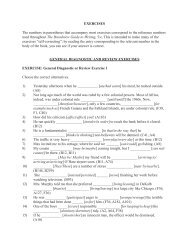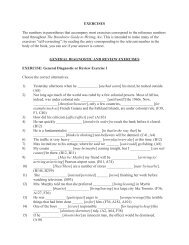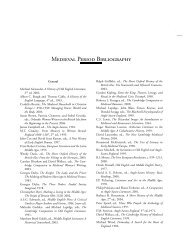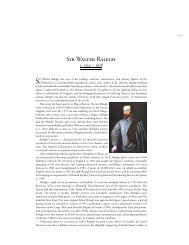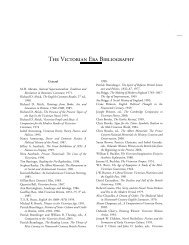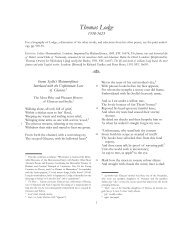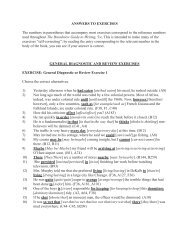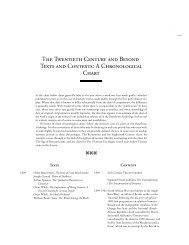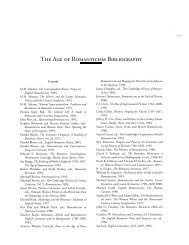SAMPLE ESSAY (MLA Style) - Broadview Press Publisher's Blog
SAMPLE ESSAY (MLA Style) - Broadview Press Publisher's Blog
SAMPLE ESSAY (MLA Style) - Broadview Press Publisher's Blog
Create successful ePaper yourself
Turn your PDF publications into a flip-book with our unique Google optimized e-Paper software.
<strong>SAMPLE</strong> <strong>ESSAY</strong> (<strong>MLA</strong> <strong>Style</strong>)<br />
What Limits to Freedom?<br />
Freedom of Expression and the Brooklyn Museum’s<br />
“Sensation” Exhibit<br />
by Melissa Davis<br />
Prof. K.D. Smith<br />
Humanities 205<br />
16 May 2009<br />
85<br />
cover page (may not<br />
be required by some<br />
instructors)<br />
all text centered<br />
03f-BGtW-AmEd 85-106.indd 85 19/01/10 4:08 PM
1<br />
name<br />
and page<br />
number in<br />
top right<br />
corner<br />
86 | sample essay<br />
What Limits to Freedom?<br />
Freedom of Expression and the Brooklyn Museum’s<br />
“Sensation” Exhibit<br />
For over a century public galleries in Western democracies have<br />
been forums not only for displaying works by “old Masters” but also<br />
for presenting art that is new, as well as ideas that are sometimes<br />
radical and controversial. In the United States that tradition has<br />
been under wide attack in the past generation. Various political and<br />
first line<br />
of all religious leaders have criticized exhibits of works of art that they claim<br />
paragraphs<br />
indented offend against notions of public decency, and have crusaded against<br />
providing public funding for the creation or display of such works.<br />
text left<br />
justified<br />
and<br />
ragged<br />
right<br />
Melissa Davis<br />
Professor Smith<br />
Humanities 205<br />
16 May 2009<br />
The largest such controversy of the past generation was sparked by the<br />
display of a painting entitled “The Holy Virgin Mary,” by the British<br />
artist Chris Ofili at the Brooklyn Museum in 1999. Though the<br />
image appears inoffensive at a distance, the artist has affixed to the<br />
painting cutouts of body parts from magazines, and has incorpo-<br />
rated clumps of elephant dung into the piece, both below the main<br />
body of the work as if supporting it and as part of the collage. The<br />
text double-spaced throughout<br />
Davis 1<br />
03f-BGtW-AmEd 85-106.indd 86 19/01/10 4:08 PM
Sample Essay | 87<br />
resulting uproar led both to a widely publicized court case and to an<br />
ongoing campaign to support “decency” in artistic expression. Should<br />
such art be banned? Should it be exhibited at public expense? In the<br />
course of the Ofili controversy cultural conservatives raised legitimate<br />
concerns about the obligation of any society to provide funding for<br />
activities of which it disapproves. This essay will argue, however, that<br />
the greater concern is in the other direction; a free society must con-<br />
tinue to provide opportunities for the free expression both of artistic<br />
vision and of controversial thought.<br />
The Ofili piece was part of a much-hyped exhibit entitled<br />
“Sensation: Young British Artists from the Saatchi Collection.” As<br />
the title indicated, the show was made up entirely of works from one<br />
collection, that of the wealthy British advertising executive Charles<br />
Saatchi. 1 The exhibition had been shown first at the Royal Academy<br />
of Arts in London and then at a major gallery in Berlin. (In London<br />
what sparked controversy was not Ofili’s work but rather a realistic<br />
painting by Marcus Harvey of child-murderer Myra Hindley that<br />
incorporated hundreds of children’s handprints into the image.)<br />
Bringing the show to Brooklyn cost one million dollars—a cost<br />
Davis 2<br />
covered in part by Christie’s, a London auctioneer—and from the<br />
outset it could be argued that the museum was courting controversy.<br />
first<br />
paragraph<br />
ends with<br />
a statement<br />
of<br />
the essay’s<br />
thesis<br />
2<br />
numbered<br />
note for<br />
additional<br />
information<br />
provided as<br />
an aside<br />
03f-BGtW-AmEd 85-106.indd 87 19/01/10 4:08 PM
3<br />
parenthetical<br />
reference;<br />
Internet<br />
source<br />
has no<br />
page<br />
number<br />
italics<br />
used for<br />
titles of<br />
books,<br />
newspapers,<br />
journals,<br />
etc.<br />
88 | sample essay<br />
It claimed in its advertising that the exhibition “may cause shock,<br />
vomiting, confusion, panic, euphoria, and anxiety. If you suffer from<br />
high blood pressure, a nervous disorder, or palpitations, you should<br />
consult your doctor” (qtd. in Barry and Vogel).<br />
No doubt that warning was tongue-in-cheek, but there was<br />
nothing ironic about the angry reactions provoked by the show in<br />
general and directed toward the Ofili piece in particular. On one side<br />
art critics and civil libertarians were full of praise; in The New York<br />
Times the work was praised as “colorful and glowing” (Kimmelman).<br />
On the other side John Cardinal O’Connor called it “an attack on<br />
religion,” and the president of the Catholic League for Religious<br />
and Civil Rights called on citizens to picket the exhibition (qtd. in<br />
Vogel). The United States Senate and the House of Representatives<br />
both passed resolutions condemning the exhibit. Even more vehement<br />
was the response of New York Mayor Rudy Giuliani (later to become<br />
famous for his leadership in the wake of the September 11, 2001<br />
terrorist attacks, and in 2008 to run for president); he declared himself<br />
“offended” and the work itself “sick” and “disgusting” (qtd. in Barry<br />
and Vogel). He ordered that ongoing city funding of the museum be<br />
withheld until the offensive work was removed, and launched eviction<br />
proceedings against the museum. Other conservative politicians—<br />
Davis 3<br />
03f-BGtW-AmEd 85-106.indd 88 19/01/10 4:08 PM
Sample Essay | 89<br />
then-Texas Governor George W. Bush prominent among them—spoke<br />
out in support of Giuliani’s stand (“Bush Backs Giuliani”).<br />
What was the substance of Mayor Giuliani’s case? Here is how he<br />
explained his stance in two statements to the press:<br />
You don’t have a right to a government subsidy to desecrate<br />
someone else’s religion. And therefore we will do everything<br />
that we can to remove funding from the [museum] until<br />
the director comes to his senses and realizes that if you are a<br />
government subsidized enterprise then you can’t do things<br />
that desecrate the most personal and deeply held views of<br />
people in society. (qtd. in Brooklyn Institute of Arts and<br />
Sciences v. City of New York 7)<br />
“If somebody wants to do that privately and pay for that<br />
privately ... that’s what the First Amendment is all about,”<br />
he said. “You can be offended by it and upset by it, and you<br />
don’t have to go see it, if somebody else is paying for it. But<br />
to have the government subsidize something like that is<br />
outrageous.” (qtd. in Vogel)<br />
But is it outrageous? Let us examine the implications of Giuliani’s<br />
argument. According to him, government should never provide<br />
Davis 4<br />
4<br />
long<br />
quotations<br />
indented—<br />
no<br />
quotation<br />
marks used<br />
except for<br />
quotation<br />
within a<br />
quotation<br />
03f-BGtW-AmEd 85-106.indd 89 19/01/10 4:08 PM<br />
5
6<br />
90 | sample essay<br />
funding for activities that some people may find deeply offensive. But<br />
governments have long funded much artistic and intellectual activity<br />
in advance on the grounds that such activity in general represents a<br />
social good, without knowing precisely what sort of artistic work will<br />
be created or exhibited, what results academic research may come up<br />
with, and so on. If such funding were to be always contingent on no<br />
one ever being deeply offended by the results of the artistic or intellec-<br />
tual activity, the effect would be to severely damage freedom of speech<br />
and expression. (Here it is important to note that the actions Giuliani<br />
took were retroactive; the annual funding for the museum had not<br />
been provided with strings attached.) 2<br />
Social conservatives are often characterized as favoring censor-<br />
ship of any material they find offensive; to be fair, that is clearly not<br />
the position Giuliani takes here. Nor is the issue whether or not the<br />
material is offensive; Hillary Clinton, for example, agreed that works<br />
such as that by Ofili were “objectionable” and “offensive” (qtd. in<br />
Davis 5<br />
Nagourney), while opposing any punitive actions against the museum.<br />
Rather, the issue at stake is under what conditions government has an<br />
obligation to fund controversial artistic or intellectual activity. To that<br />
question at least one short answer should be plain: an obligation exists<br />
where a prior commitment has been made. As Judge Nina Gershon<br />
03f-BGtW-AmEd 85-106.indd 90 19/01/10 4:08 PM
put it in her eventual ruling on the case,<br />
Sample Essay | 91<br />
the issue is ... whether the museum, having been allocated<br />
a general operating subsidy, can now be penalized with<br />
the loss of that subsidy, and ejectment from a City-owned<br />
building, because of the perceived viewpoint of the works<br />
in that exhibit. The answer to that question is no. (Brook-<br />
lyn Institute v. City of New York 17)<br />
Where such a commitment has been made it can only be fairly broken<br />
if the activity has in some way contravened previously agreed-on<br />
guidelines or if it has broken the law. If, for example, a work of art or<br />
of literature is thought to violate laws against obscenity, laws concern-<br />
ing hate crimes, laws concerning libel and slander—or, indeed, laws<br />
concerning cruelty to animals, as in the cases of certain “works of art”<br />
in recent years 3 —then legal recourse is available. But not even the<br />
Davis 6<br />
most vociferous of the opponents of the “Sensation” exhibit suggested<br />
that Ofili, the curators, or anyone else had broken the law. Moreover,<br />
the ongoing funding for the Museum had never been made contin-<br />
gent on the institution’s exhibits never offending anyone. There were<br />
therefore no just grounds for taking punitive action as Giuliani did.<br />
But how much further than this should the obligation of govern-<br />
ment to fund controversial artistic or intellectual activity extend? Do<br />
03f-BGtW-AmEd 85-106.indd 91 19/01/10 4:08 PM<br />
7<br />
8
9<br />
no citation<br />
needed<br />
for<br />
information<br />
that is<br />
common<br />
knowledge<br />
92 | sample essay<br />
governments have a general or unrestricted obligation to support and<br />
to fund such activity? The tradition of government support for artistic<br />
and intellectual activity in Western democracies has for many genera-<br />
tions been one in which support was provided at “arm’s length” from<br />
the political process; if judgments based on the merit of individual<br />
works need be made, they are typically made by bodies independ-<br />
ent of government. That approach has stemmed from a number of<br />
sensible general principles. One such principle has been a recognition<br />
of the inherent value of intellectual and artistic activity. Another has<br />
been a recognition that such activity will sometimes be challenging,<br />
disturbing, even offensive or disgusting. 4 And a third has been that<br />
if politicians are involved in judging individual artistic or intellectual<br />
works, the judgments will tend to be made more on political and<br />
religious grounds than on intellectual and esthetic ones. We value a<br />
society in which a wide range of free expression is supported, and we<br />
have come to expect that governments will provide a good deal of that<br />
support.<br />
Davis 7<br />
Despite the general support for these principles that exists in our<br />
society, we should not assume an unlimited obligation on the part of<br />
government. In particular, liberals and civil libertarians are unwise if<br />
they suggest that the obligation of the government to support artistic<br />
03f-BGtW-AmEd 85-106.indd 92 19/01/10 4:08 PM
Sample Essay | 93<br />
or intellectual endeavor is always a strong and compelling one, or<br />
that any failure of a government to provide financial support for such<br />
endeavor somehow constitutes censorship. 5 There is no clear agree-<br />
ment as to what constitutes art; it follows that there can be no legal<br />
or moral obligation to fund everything that may be classified as art.<br />
And to decide in advance not to subsidize an activity is not the same<br />
as censoring that activity; civil libertarians do not advance their case<br />
by equating the two. Indeed, as philosopher Peter Levine has pointed<br />
out, attempts to remove all restrictions on government support can<br />
easily backfire, since the law<br />
cannot compel governments to subsidize art in the first<br />
place. When the Supreme Court ruled in 1998 that<br />
individual artists may not be denied federal grants because<br />
of the content of their work, Congress simply cancelled all<br />
support for individual artists. (2)<br />
If it is a great mistake for the artistic and intellectual com-<br />
Davis 8<br />
munities to press too hard for unrestricted government support, it is<br />
perhaps an even greater mistake for cultural conservatives to seek to<br />
restrict government support to work that conforms to their definition<br />
of “decency.” The moral obligation of government to support a broad<br />
range of artistic and intellectual expression may be a relatively weak<br />
sentence<br />
structured<br />
so that<br />
it flows<br />
grammatically<br />
into<br />
quotation<br />
03f-BGtW-AmEd 85-106.indd 93 19/01/10 4:08 PM<br />
10
94 | sample essay<br />
one, but if we cast it aside we are choosing to narrow ourselves, to<br />
discourage rather than encourage the sorts of challenge from new ideas<br />
and new artistic expressions that continually replenish the red blood<br />
cells of democratic society. In approaching such questions we should<br />
ask ourselves what really constitutes freedom of thought, speech, and<br />
expression. One defining pillar is legal: constitutional guarantees of<br />
freedom and the case law that has helped to define them. 6 But is that<br />
all there is to it? A moment’s reflection should make it clear that a<br />
great deal else is involved. Regardless of what is allowed or prohibited,<br />
if there exists a scarcity of art galleries—or of book publishers, or<br />
of academic journals, or of newspapers, or of radio and television<br />
stations—that are willing to put forward original and controversial<br />
works of art, or works of scholarly research, or political treatises, then<br />
freedom of speech and expression is in practice severely limited. 7 And<br />
economic reality dictates that a number of valued activities, including<br />
academic research as well as many of the arts, would be severely cur-<br />
tailed without some degree of public funding. If we choose as a society<br />
not to fund such activities we will inevitably be erecting real barriers<br />
against freedom of speech and expression, even if we have passed no<br />
laws restricting such freedoms. That is the reality at the heart of the<br />
“Sensation” controversy.<br />
Davis 9<br />
03f-BGtW-AmEd 85-106.indd 94 19/01/10 4:08 PM
Sample Essay | 95<br />
It is interesting that in the midst of the controversy Ofili’s work<br />
itself became oddly invisible, lost in the clamor of arguments from<br />
principle on both sides of the debate. Photographic representations<br />
of “Holy Virgin Mary” are widely available on the Web, 8 and viewers<br />
coming to these after sampling the heat of the arguments surrounding<br />
the piece are likely to be surprised by how calm and pleasant an image<br />
is presented to them. Ofili himself was the recipient of the prestigious<br />
Turner Prize in 1998 and has been widely recognized as one of the<br />
most important of his generation of British artists. Fairly typical are<br />
the comments of a writer in Art in America, one of the most authori-<br />
tative journals of contemporary art criticism: “his paintings are a<br />
joy to behold.... His technique, as it becomes ever richer and more<br />
complex, is developing an emotional range to match its decora-<br />
tive facility” (MacRitchie). The painter, who was born in Britain to<br />
parents of Nigerian background, was raised—and still remains—a<br />
church-going Catholic. (Clearly critics’ claims that “The Holy Virgin<br />
Mary” is offensive to Catholics cannot be true of all Catholics!) Ofili<br />
has spoken interestingly of how he draws connections between the<br />
subjects of his work and the materials he uses, including shiny varnish<br />
to make it seem that the subject of a painting is “in some ways more<br />
imagined than real” (qtd. in Vogel), and, of course, the notorious<br />
Davis 10<br />
11<br />
parenthetical<br />
references<br />
at end<br />
of short<br />
quotations<br />
followed<br />
by end<br />
punctuation<br />
03f-BGtW-AmEd 85-106.indd 95 19/01/10 4:08 PM
quotation<br />
with<br />
author<br />
named<br />
in signal<br />
phrase;<br />
page<br />
number<br />
in parentheses<br />
title cited<br />
when work<br />
has no<br />
attributed<br />
author<br />
12<br />
96 | sample essay<br />
balls of elephant dung that adorn the work and on which it rests. 9<br />
Significantly, Ofili has incorporated dung into many of his works,<br />
including those portraying slaves and other African subjects. As<br />
Arthur C. Danto has pointed out, “since it is unlikely that as a black<br />
Anglo-African Ofili would have used dung to besmirch the slaves [in<br />
the picture “Afrobluff”], there is no reason to suppose he was bent on<br />
besmirching the Holy Virgin through its presence there either” (2).<br />
From one angle, Ofili clearly sees the use of dung as a way of connect-<br />
ing his paintings to his African heritage and of giving the paintings “a<br />
feeling that they’ve come from the earth” (qtd. in Vogel). But he also<br />
aims to create a tension between the superficially appealing nature of<br />
his images and the inherent unpleasantness of some of the materials he<br />
has used to create them:<br />
“The paintings themselves are very delicate abstractions, and<br />
I wanted to bring their beauty and decorativeness together<br />
with the ugliness of shit 10 and make them exist in a twilight<br />
zone—you know they’re together, but you can’t really ever<br />
feel comfortable about it.” (qtd. in Sensation)<br />
One does not need to endorse all of Ofili’s theorizing about what he<br />
does, or agree fully with the favorable assessments of the critics in<br />
Davis 11<br />
order to conclude that it would be unreasonable not to classify his<br />
03f-BGtW-AmEd 85-106.indd 96 19/01/10 4:08 PM
Sample Essay | 97<br />
work as art. Even the narrowest and most conservative definitions<br />
of art allow the term to be applied to work that many people find<br />
pleasing to the eye and that many agree demonstrates creative skill.<br />
Ofili’s work unquestionably fulfills those criteria. More than that,<br />
there is evidently a good deal of subtlety and nuance to both the<br />
work and the ideas of this painter, far more than the polarized debate<br />
swirling around the painting might suggest. Even if some find this art<br />
offensive, it is hard not to think that on its merits Ofili’s work deserves<br />
to be widely exhibited.<br />
In a narrow sense the controversy of the Ofili work and the Sen-<br />
sation exhibit ended with a clear victory for the Brooklyn Museum.<br />
Federal Judge Nina Gershon ruled that in these circumstances the<br />
City of New York’s attempt to shut down the exhibit constituted a vio-<br />
lation of the First Amendment—the Constitutional guarantee of free-<br />
dom of expression—and in March of 2000 the City and the museum<br />
reached an agreement under the terms of which all further lawsuits<br />
were dropped and the City agreed to contribute 5.8 million dollars<br />
towards a museum restoration project. (The museum re-opened in<br />
2004 after the completion of restorations.) But in a wider sense the<br />
outcome is far less certain. In 2001 Mayor Giuliani attempted to<br />
Davis 12<br />
develop “decency standards” intended to restrict these sorts of works<br />
03f-BGtW-AmEd 85-106.indd 97 19/01/10 4:08 PM<br />
13
98 | sample essay<br />
from being shown in future in publicly funded exhibitions, and such<br />
initiatives received strong support from the administration of George<br />
W. Bush. Among certain commentators the crusade against Ofili has<br />
continued unabated long after the exhibit itself had ended. Phyllis<br />
Schlafly is one such crusader (1999); Tammy Bruce is another. In<br />
her best-selling book The Death of Right and Wrong, for example,<br />
Bruce uses the case as an example in urging us to “make no mistake:<br />
the degrading of symbols important to Christianity is ... propaganda<br />
meant to change your view of Christianity as a whole” (52). Given the<br />
persistence of attacks of this sort, major museums and galleries must<br />
have real courage to mount exhibitions of work that they consider<br />
likely to be controversial. Tellingly, the “Sensation” exhibit was never<br />
seen after it closed in Brooklyn; the National Gallery of Australia<br />
Davis 13<br />
canceled its plans to show the exhibit, and a Tokyo museum that had<br />
expressed interest in exhibiting it thereafter did not in the end make<br />
any commitment (Rosenbaum). More recently, the San Francisco Art<br />
Institute closed Adel Abdessemed’s controversial “Don’t Trust Me”<br />
show after only a few days “for safety reasons” (DeBare B1) in the face<br />
of protests by animals’ rights groups and some artists, though there<br />
had been no suggestion that any law had been broken, and though<br />
condemnation of the show had been far from universal. 11<br />
03f-BGtW-AmEd 85-106.indd 98 19/01/10 4:08 PM
Sample Essay | 99<br />
Legal victories in defense of freedom of expression, then, will<br />
never in themselves suffice. The preservation of a truly open society<br />
requires, on the part of those who wish to allow and to encourage<br />
freedom of expression, a moral determination that is at least as strong<br />
as the moral determination of those who wish to roll back its frontiers.<br />
Much as constitutional guarantees of freedom of expression are<br />
important, even more so is whether we wish as a society to narrow the<br />
range of what citizens may readily see or hear, or instead to encour-<br />
age the wide dissemination of information, opinion, and artistic<br />
expression—even opinions and artistic expressions that some may<br />
find offensive. In the years since the September 11, 2001 attack, it is<br />
understandable that many both within the United States and around<br />
the world have been prepared to accept some new restrictions on<br />
freedom. But whatever justification there may be for such restrictions<br />
does not extend to the sphere of intellectual and artistic activity. If we<br />
wish to retain a robustly democratic society we should continue to<br />
choose the path of openness.<br />
Davis 14<br />
14<br />
final<br />
paragraph<br />
restates<br />
and<br />
broadens<br />
the essay’s<br />
main<br />
argument<br />
03f-BGtW-AmEd 85-106.indd 99 19/01/10 4:08 PM
notes<br />
numbered<br />
as in text<br />
each note<br />
indented<br />
100 | sample essay<br />
Notes<br />
1. Saatchi contributed $100,000 to mounting the show, the<br />
economics of which became another subject for controversy when it<br />
was shown in Brooklyn. As well as complain about the content of the<br />
works in the exhibit, Mayor Rudy Giuliani and others suggested that<br />
the show had been intended in large part to raise the value of works<br />
in the Saatchi collection, and on those grounds, too, argued that the<br />
exhibit should not be receiving a subsidy from taxpayers.<br />
2. Because its content was recognized as controversial, city<br />
officials had been provided in advance of the “Sensation” show with<br />
photographs and full descriptions of all pieces to be included in the<br />
exhibit, including the information that Ofili’s works incorporated<br />
elephant dung into the images they portrayed. The mayor insisted<br />
that he personally had not been alerted to the content of the show<br />
beforehand, however.<br />
3. Animal rights activists have protested against works by the<br />
renowned British artist Damien Hirst, which present, among other<br />
things, a sectioned cow and a bisected pig in formaldehyde cases.<br />
Davis 15<br />
(Several such works by Hirst were included in the “Sensation” show.)<br />
In Toronto, art student Jesse Power and two friends pleaded guilty in<br />
03f-BGtW-AmEd 85-106.indd 100 19/01/10 4:08 PM
Sample Essay | 101<br />
2001 to charges of animal cruelty and public mischief after making<br />
what they called an art video recording their torturing and killing a<br />
cat; the case again aroused controversy in 2004 following the release of<br />
a documentary film about the incident, Casuistry: The Art of Killing a<br />
Cat, directed by Noah Cowan and Piers Handling. See also the articles<br />
by Christie Blatchford and by Gayle MacDonald, and Note 11 below<br />
on the 2008 “Don’t Trust Me” exhibition in San Francisco.<br />
4. There are many defenses of the principle that an open society must<br />
make a place even for controversial or disgusting material. The case for the<br />
other side is put by John Kekes in A Case for Conservatism; he argues for<br />
what he terms “the moral importance of disgust” (100–109).<br />
5. To be fair, although some individuals make assertions as<br />
extreme as this one, responsible civil liberties organizations such as the<br />
ACLU stop short of any such all-embracing claim.<br />
6. The First Amendment to the American Constitution specifies<br />
that Congress “shall make no law ... abridging the freedom of speech,<br />
or of the press; or the right of the people to assemble....” In American<br />
legal practice it has long been established that “freedom of speech”<br />
should also cover other forms of expression—such as artistic works.<br />
Other, more recent constitutions tend to make such protections<br />
explicit; the Charter of Rights and Freedoms that forms a central<br />
Davis 16<br />
03f-BGtW-AmEd 85-106.indd 101 19/01/10 4:08 PM
102 | sample essay<br />
part of the Canadian Constitution, for example, protects “freedom<br />
of thought, belief, opinion, and expression, including freedom of the<br />
press and other media of communication.”<br />
7. A good example of how such freedoms may be constrained<br />
is the March 2003 case in which Natalie Maines of the Dixie Chicks<br />
criticized George W. Bush—and promptly found that two media con-<br />
glomerates controlling over 1,300 radio stations refused to play Dixie<br />
Chicks music. That case is discussed by Robert B. Reich in Reason:<br />
Why Liberals Will Win the Battle for America.<br />
8. Among the many Web addresses at which photographs of the<br />
work may be found are www.artsjournal.com/issues/Brooklyn.htm<br />
and www.postmedia.net/999/ofili.htm and www.geocities.com/south-<br />
ernhelle/sensation3.html.<br />
9. Many who have attacked the piece have chosen to describe the<br />
dung as being “smeared on a Christian icon” (Bruce 39, my italics),<br />
which is substantially to misrepresent the nature of the work.<br />
10. It is interesting to contemplate the impact diction may have<br />
on arguments such as this; it is difficult not to respond slightly differ-<br />
ently depending on whether the material is referred to using the noun<br />
Ofili uses here or referred to less provocatively as “dung.”<br />
Davis 17<br />
11. The show included video clips of the killing of animals in<br />
03f-BGtW-AmEd 85-106.indd 102 19/01/10 4:08 PM
Sample Essay | 103<br />
Davis 18<br />
rural Mexico. The artist had evidently not arranged for the killings; he<br />
was merely recording local practice. For more on this and other recent<br />
controversies, see the articles by Kenneth Baker and Phoebe Hoban.<br />
03f-BGtW-AmEd 85-106.indd 103 19/01/10 4:08 PM
104 | sample essay<br />
works cited are<br />
listed alphabetically<br />
each<br />
entry<br />
begins<br />
at left<br />
margin;<br />
subsequent<br />
lines<br />
are in-<br />
dented<br />
Works Cited<br />
Baker, Kenneth. “Show’s Cancellation a Rare Case of Artists Advocating Cen-<br />
sorship.” San Francisco Chronicle 1 Apr. 2008: E1. Print.<br />
Barry, Dan, and Carol Vogel. “Giuliani Vows to Cut Subsidy over Art He Calls<br />
Offensive.” New York Times 23 Sept. 1999: n. pag. Web. 2 May 2009.<br />
Blatchford, Christie. “Face to Face with Cruelty.” Globe and Mail 4 Sept. 2004:<br />
A13. Print.<br />
Brooklyn Institute of Arts and Sciences v. City of New York 99CV 6071. New<br />
York Law Journal 1 Nov. 1999: n. pag. Web. 1 May 2009.<br />
Bruce, Tammy. The Death of Right and Wrong. New York: Three Rivers, 2003.<br />
Print.<br />
“Bush Backs Giuliani on Museum Flap.” Associated <strong>Press</strong> 4 Oct. 1999: n. pag.<br />
Washingtonpost.com. Web. 3 May 2009.<br />
Danto, Arthur C. “‘Sensation’ in Brooklyn.” The Nation 1 Nov. 1999: n. pag.<br />
Web. 1 May 2009.<br />
DeBare, Ilana. “Art Institute Halts Exhibition Showing Killing of Animals.” San<br />
Francisco Chronicle 30 Mar. 2008: B1. Print.<br />
Hoban, Phoebe. “How Far Is Too Far?” ArtNews Summer 2008: 145-49. Print.<br />
Kekes, John. A Case for Conservatism. Ithaca, New York: Cornell UP, 1988.<br />
Print.<br />
Davis 19<br />
03f-BGtW-AmEd 85-106.indd 104 19/01/10 4:08 PM
Sample Essay | 105<br />
Kimmelman, Michael. “A Madonna’s Many Meanings in the Art<br />
Davis 20<br />
World.” New York Times 5 Oct. 1999: n. pag. Web. 2 May 2009.<br />
Levine, Peter. “Lessons from the Brooklyn Museum Controversy.”<br />
Philosophy and Public Policy Quarterly 20.2/3 (2000): n. pag.<br />
Web. 3 May 2009.<br />
MacDonald, Gayle. “TIFF Contacts Police over Death Threat: Caller<br />
Threatens Programmer over Cat-Killer Documentary.” Globe and<br />
Mail 1 Sept. 2004: R1. Print.<br />
MacRitchie, Lynn. “Ofili’s Glittering Icons.” Art in America Jan. 2000:<br />
n. pag. Find Articles at BNET. BNET. Web. 1 May 2009.<br />
Nagourney, Adam. “First Lady Assails Mayor over Threat to<br />
Museum.” New York Times 28 Sept. 1999. n. pag. Web. 1 May<br />
2009.<br />
Reich, Robert B. Reason: Why Liberals Will Win the Battle for America.<br />
New York: Knopf, 2004. Print.<br />
Rosenbaum, Lee. “The Battle of Brooklyn Ends, the Controversy<br />
Continues.” Art in America June 2000: n. pag. Find Articles at<br />
BNET. BNET, n.d.Web. 4 May 2009.<br />
Schlafly, Phyllis. “Time to Abolish Federally Financed ‘Hate Art.’”<br />
Eagle Forum. Eagle Forum, 13 Oct. 1999. Web. 2 May 2009.<br />
double<br />
spacing<br />
used<br />
throughout<br />
italics used<br />
for titles<br />
of books,<br />
journals,<br />
magazines,<br />
etc.<br />
03f-BGtW-AmEd 85-106.indd 105 19/01/10 4:08 PM
106 | sample essay<br />
Sensation: Young British Artists from the Saatchi Collection. Guide-<br />
book. Geocities.com. Yahoo, n.d. Web. 2 May 2009.<br />
“Turner Prize: Twenty Years.” Tate Gallery Online. Tate Gallery,<br />
2003. Web. 1 May 2009.<br />
Vogel, Carol. “Chris Ofili: British Artist Holds Fast to His<br />
Inspiration.” New York Times 28 Sept. 1999: n. pag. Web.<br />
2 May 2009.<br />
Davis 21<br />
03f-BGtW-AmEd 85-106.indd 106 19/01/10 4:08 PM


